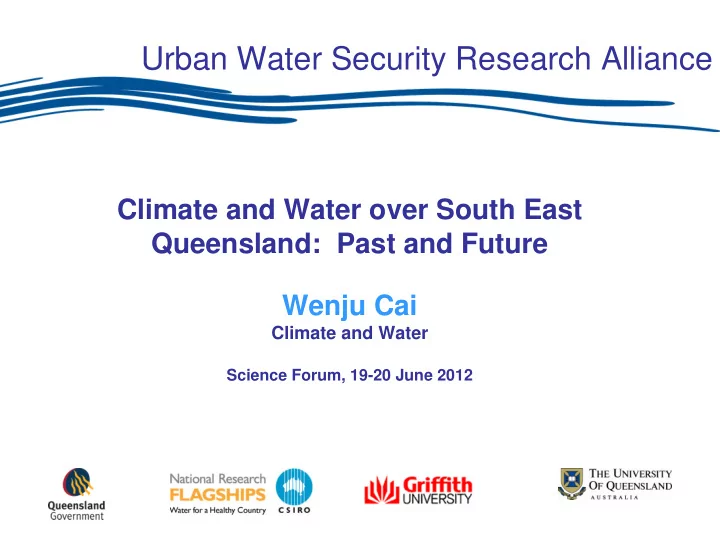

Urban Water Security Research Alliance Climate and Water over South East Queensland: Past and Future Wenju Cai Climate and Water Science Forum, 19-20 June 2012
Considering Climate Change Figure sourced from SEQ Water Strategy The current SEQ Water Strategy considers climate change as a change to the maximum yield that can be delivered while meeting the pre-determined Level of Service (LOS) performance objectives.
Time sequence of SEQ water storage level (1890-2009)
Research Questions … • Research question 1: What causes drought in the SEQ region, and how the properties of drought (intensity, duration and frequency) may change in a warming climate, in addition to forcing by multidecadal variability (in conjunction with QCCCE) . • Research question 2: How best to translate global projections of climate change (rainfall and other hydrological fields) into future water availability information (in collaboration with DERM). • Research question 3: How sensitive to the resolution of climate information is the SEQ stream- flow model (IQQM).
Most models do not produce the observed trends Cai et al. 2010: Asymmetry in ENSO Teleconnection with Regional Rainfall, Its Multidecadal Variability, and Impact. J. Climate, 23, 4944–4955
2011 SEQ summer rainfall
El Niño & La Niña Index NINO-3.4 NINO3.4 ≥ ≥ 0.5° °C for 5 months= El Ni C for 5 months= El Niñ ño o NINO3.4 0.5 NINO3.4 ≤ ≤ -0.5 0.5° °C for 5 months= La Ni C for 5 months= La Niñ ña a NINO3.4 - Courtesy of McPdaden
Cai et al. 2010
The nonlinearity oscillates on decadal time scale La Niña El Niño
El Niño ? La Niña El Niño La Niña
Negative PDO Positive PDO La Nina El Nino El Nino La Nina
Cai et al. 2010
Cai and van Rensch (2012) The 2011 southeast Queensland extreme summer rainfall: a confirmation of a negative Pacific Decadal Oscillation phase? The flood constitutes a confirmation of the PDO changing to a negative phase The result implies an increased chance of high summer rainfall events over the region during La Niña events in the upcoming decade or so.
Really becoming negative 95% significance
Model Details KINGAROY KINGAROY NAMBOUR The hydrologic model used in this NAMBOUR NANANGO BUDERIM NANANGO BUDERIM study covers the Brisbane River CALOUNDRA catchment upstream of the tidal CALOUNDRA limit KILCOY WOODFORD KILCOY WOODFORD Somerset Dam Somerset Dam CABOOLTURE CABOOLTURE Historic rainfall and evaporation DECEPTION BAY DECEPTION BAY data is sourced from SILO ESK CROWS NEST ESK CROWS NEST Wivenhoe Dam Wivenhoe Dam OAKEY Urban demands are set to full OAKEY BRISBANE BRISBANE utilisation of existing entitlements, TOOWOOMBA GATTON TOOWOOMBA GATTON IPSWICH approximately 280 GL/a, with no IPSWICH LAIDLEY LAIDLEY restriction rules in place PITTSWORTH PITTSWORTH The model simulation period is BEAUDESERT BOONAH BEAUDESERT BOONAH from 1889 to 2000 STUDY AREA STUDY AREA
Climate Change Models Analysed Global Circulation Model (GCM) Cubic Conformal Atmospheric Model (CCAM) downscaling Model Emissions Model Emissions Scenario 1 Scenario 1 CSIRO Mark 3.0 A2 CSIRO Mark 3.0 A2 CSIRO Mark 3.5 A2 CSIRO Mark 3.5 A2 GFDL CM 2.1 A2 GFDL CM 2.1 A2 MIROC 3.2 (medres) A2 MIROC 3.2 (medres) A2 8 Directly Comparable MPI ECHAM 5 A2 MPI ECHAM 5 A2 NCAR CCSM 3.0 A2 NCAR CCSM 3.0 A2 UKMO HADCM3 A2 UKMO HADCM3 A2 UKMO HADGEM1 A2 UKMO HADGEM1 A2 IAP FGOALS 1.0 A1B INMCM 3.0 A2, A1B MIROC 3.2 (hires) A1B CSIRO Mark 3.0 A1B 6 Additional Models MIUB echo A2 NCAR CCSM 3.0 A1B 1 All model projections were scaled to Emissions Scenario A1FI
Spatial Variation of Climate Projections Monthly percentage rainfall change for Monthly percentage evaporation change for downscaled CSIRO Mk 3.5 (for year 2050 SRES A1FI) downscaled CSIRO Mk 3.5 (for year 2050 SRES A1FI) (source Kent, D., CSIRO) (source Kent, D., CSIRO) • Spatial variation in downscaled projections is more pronounced for rainfall than for evaporation
Downscaling Effects on Rainfall Mean Monthly Rainfall - Subcatchment UB1 (07/1889-06/2000) Global Circulation Model Generation Method (GCM) 160 Mean Monthly Rainfall (mm) 120 80 40 0 Jan Feb Mar Apr May Jun Jul Aug Sep Oct Nov Dec Month • Downscaled models display greater variability in rainfall projections than GCMs, but generally result in reduced wet season rainfall
Downscaling Effects on Evaporation Mean Monthly Evaporation (mm) Mean Monthly Evaporation (mm) • Downscaled models display greater variability in evaporation projections and are generally higher than the original GCM projection • Some of this difference may be attributed to the method of calculating the evaporation change within CCAM • not all GCMs produced evaporation output (ie. evaporation was derived from temperature relationships)
Downscaling Effects on Runoff Generation • The combination of increased evaporation and decreased wet season rainfall results in significantly reduced runoff generation/inflow to the hydrologic model (IQQM)
Climate Change Effect on Storage Behaviour (GCM) Combined Simulated Storage Volume Somerset and Wivenhoe Dams Global Circulation Model Generation Method (GCM) 2500000 Several GCMs result in increased storage volume 2000000 1500000 75% 1000000 50% 500000 25% DSV 0 Date
Downscaling Effects on Storage Behaviour (CCAM) All but one The system does downscaled GCM result in decreased not recover from storage volumes the federation drought until 1927! Storage Volume (ML) 1970 1980 1910 1920 1930 1940 1950 1960 1990 2000 1890 1900
Comparison of Median GCM and CCAM Projections The combined effect of reduced rainfall and increased evaporation cause the gradual decline in storage volume during these two periods
No Rainfall Change Results (GCM)
No Rainfall Change Results (CCAM)
Urban Water Security Research Alliance THANK YOU www.urbanwateralliance.org.au
Raw Pan evaporation (epan_ave) extracted from CCAM
Recommend
More recommend